- NEW: Communications company says its satellite didn't reach proper orbit
- One of nine rocket engines failed on the SpaceX booster after Sunday's launch
- The flight computer adjusted for the failure and kept the Dragon capsule on course
- The unmanned capsule is scheduled to reach the space station on Wednesday
(CNN) -- The SpaceX Dragon capsule remains on course for the International Space Station despite losing one of nine booster engines, but a satellite launched on the same rocket didn't reach its intended orbit, its operator said Monday.
SpaceX launched the first commercial space cargo mission on Sunday night. But a minute and 19 seconds after the Falcon 9 booster lifted off from Cape Canaveral, Florida, one of the nine Merlin engines that power the rocket "lost pressure suddenly," the company disclosed Monday.
The rocket "did exactly what it was designed to do," as its flight computer made adjustments to keep the Dragon headed into the proper orbit. The unmanned capsule, which is carrying about 1,000 pounds of supplies for the space station, is scheduled to arrive at the orbital platform on Wednesday, SpaceX said.
However, the rocket also was carrying a satellite for the New Jersey-based communications company Orbcomm. The satellite separated properly from the second stage of the Falcon 9 -- but the engine trouble meant the satellite would not pass clear of a safety zone if it fired its own engine, leaving it in a lower orbit than planned, Orbcomm said in a statement issued Monday night.
Engineers from Orbcomm and its partner on the project, Sierra Nevada Corporation, "have been in contact with the satellite and are working to determine if and the extent to which the orbit can be raised to an operational orbit using the satellite's on-board propulsion system," the statement said.
Neither SpaceX nor Orbcomm responded to request for comment about the satellite issue. California-based SpaceX said earlier that controllers are reviewing flight data in an effort to figure out what happened to the booster rocket, but initial readings indicate the No. 1 engine fairing broke apart under stress.
"We know the engine did not explode, because we continued to receive data from it," the company said. But it said two of NASA's Saturn V boosters lost engines on two flights during the Apollo program, and the Falcon 9 "is designed to handle an engine-out situation and still complete its mission."
The failure occurred second after the booster achieved supersonic speed and approached its moment of maximum aerodynamic pressure after liftoff. Video posted online by the company shows a flash as the rocket ascends, followed by what appears to be debris falling away from the accelerating craft.
Sunday's launch was the first of a dozen freight runs SpaceX is slated to make o the station under a contract with NASA, which plans to turn much of its focus toward exploring deep into the solar system. NASA Administrator Charles Bolden called it "a critical event in space flight."
SpaceX, meanwhile, is looking beyond just cargo flights to developing a human-rated version of the Dragon that would carry astronauts to the ISS. It's one of three companies, along with Sierra Nevada and aerospace giant Boeing, that NASA has chosen to work on the project.
And within the next few months, Orbital Sciences is expected to fly its own demonstration flight to the space station. Instead of using Cape Canaveral as its launch site, the company's rocket will take off from Wallops Island, off the coast of Virginia. Orbital has a nearly $2 billion contract with NASA for station resupply missions.



 The SpaceX rocket lifts off Sunday, October 7, marking the first commercial flight to the International Space Station. It was the first of a dozen NASA-contracted flights to resupply the station.
The SpaceX rocket lifts off Sunday, October 7, marking the first commercial flight to the International Space Station. It was the first of a dozen NASA-contracted flights to resupply the station. 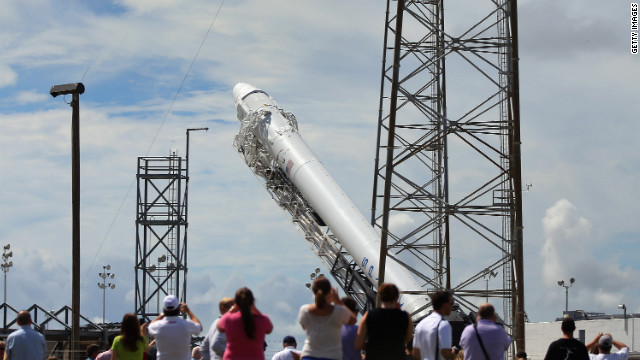 People watch as the SpaceX Falcon 9 rocket and its unmanned Dragon capsule are readied for launch Sunday in Cape Canaveral, Florida.
People watch as the SpaceX Falcon 9 rocket and its unmanned Dragon capsule are readied for launch Sunday in Cape Canaveral, Florida. 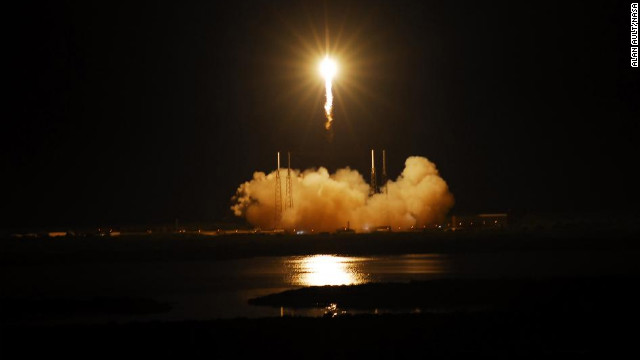 On May 22, SpaceX launched a successful test flight that attached a spacecraft to the International Space Station. It was the first company to do so.
On May 22, SpaceX launched a successful test flight that attached a spacecraft to the International Space Station. It was the first company to do so.  Dragon's recovery team poses in front of the first commercial capsule to reach orbit and return safely to Earth.
Dragon's recovery team poses in front of the first commercial capsule to reach orbit and return safely to Earth. 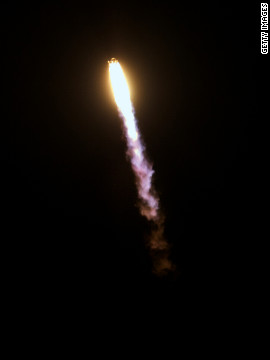
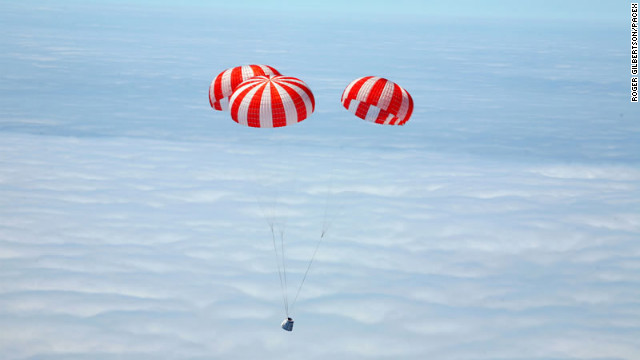 This image shows how Dragon returns to Earth, under parachutes, to splashdown in the ocean, much like the spacecraft of Mercury, Gemini and Apollo.
This image shows how Dragon returns to Earth, under parachutes, to splashdown in the ocean, much like the spacecraft of Mercury, Gemini and Apollo. 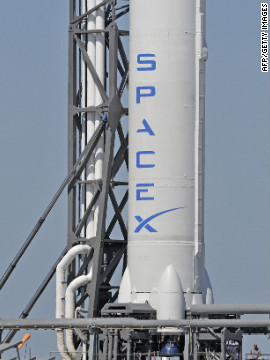
 The first Dragon capsule to make it into orbit and return to Earth was launched in December 2010. Here, crews haul the charred capsule out of the ocean.
The first Dragon capsule to make it into orbit and return to Earth was launched in December 2010. Here, crews haul the charred capsule out of the ocean.  SpaceX's Falcon 9, carrying a Dragon space capsule, launches from Cape Canaveral in December 2010.
SpaceX's Falcon 9, carrying a Dragon space capsule, launches from Cape Canaveral in December 2010. 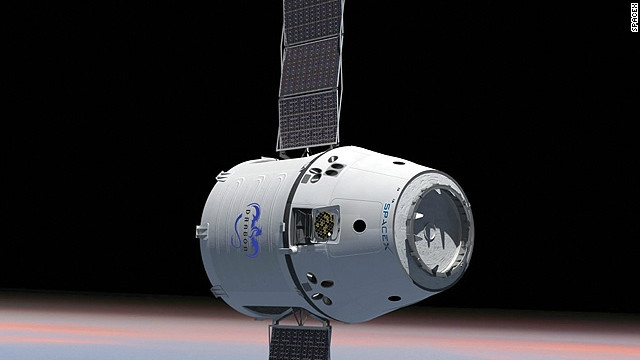 This rendering of the Dragon capsule shows the craft's solar panels fully extended. The capsule launched in May extended its panels in orbit.
This rendering of the Dragon capsule shows the craft's solar panels fully extended. The capsule launched in May extended its panels in orbit.